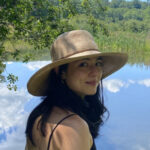Lab 3: Discovering Plate Boundaries Continuing Discussion
- This topic has 8 replies, 7 voices, and was last updated Mar 1, 2021, 12:07 pm by .
-
AuthorPosts
-
February 22, 2021 at 3:18 pm #109345
 Francesca LingoParticipant
Francesca LingoParticipantContinuing Discussion – Due on Sunday 2/28/2020 11:59 pm
Take some time to compare your boundary classifications with those provided by others in your group and begin thinking about how you could condense these into a single classification system in which each boundary is associated with a specific pattern of earthquakes, volcanoes, topography, and seafloor age (if the boundary is on the seafloor). As a group, discuss, based on your work so far, what this classification system should look like and work toward a consensus.
Note – there is no “right” answer for this activity. The goal of this activity is to encourage you to practice making and sharing observations and to become more familiar with the geologic features that occur at different plate boundaries and how these are distributed.
This topic was also posted in: EAS 10600 #M Group B, EAS 10600 #M Group D, EAS 10600 #M Group E, EAS 10600 #M Group F, EAS 10600 #M Group A.February 27, 2021 at 4:39 pm #109974 BYUNGJUN SHIMParticipant
BYUNGJUN SHIMParticipantI enjoyed doing this lab3 because the maps were straight forward which was easy to understand the map. I liked observing different plate boundaries that have specific characters such as the patterns of earthquakes topography, and seafloor ages. The most intriguing part was the earthquake map. Most of the earthquakes were clustering around the Pacific plates. For example, I watched the news that Japan was struck by one of the powerful earthquakes and tsunami on record in 2011. Now I understand why Japan and other countries are exposed to earthquakes.
February 28, 2021 at 6:09 pm #110048 Joseph TatisParticipant
Joseph TatisParticipantI agree with what you enjoyed about this lab. I also found it interesting that the Pacific and Australian plates were clustered with earthquakes. It is interesting that you found an example in history such as Japan that shows how reliable the maps are in understanding.
February 28, 2021 at 8:32 pm #110062 Nicolas MateusParticipant
Nicolas MateusParticipantThe lab experiment was thoroughly demonstrated the reoccurring patterns to which we were able to identify the ways in which plate boundaries and their movements displaying how they materialize on Earth through natural occurrences. Disasters we know to re-occur on a known pattern that we are able to visualize and track through these maps. More importantly, it allowed us to look into the future, in order to take preventative measures to compensate for anything that might happen. Take for example the known pattern of the “Ring of Fire” movements we are able to visualize on the marked Volcano map and the marked Earthquake map.
February 28, 2021 at 8:42 pm #110065 Nicolas MateusParticipant
Nicolas MateusParticipantByungjun,
I have to say I do agree with the map showing and explaining why certain natural occurrences, tracking these natural disasters does indeed make them more predictable. One other occurrence we can draw conclusions to is the earthquake that struck Hati in 2010, with a magnitude of 7.0. Concurrently Hati is a landmass that also is marked on the map we used in the experiment for Earthquake depth magnitudes and consistency. This lab proves to useful even for future endeavors.
February 28, 2021 at 11:23 pm #110089 Saundarya SharmaParticipant
Saundarya SharmaParticipantThis lab was very interesting to do and the question/answers were very informative. The maps were well made and very easy to follow through. The plate boundaries and reoccurring patterns were studied which helped me answer all the questions for this lab. It gave me a better understanding of why some countries experience more earthquakes and Volcanoes and other natural disasters than other countries. When Earth’s tectonic plates grind past one another, enormous amounts of energy can be released in the form of earthquakes.Understanding these patterns we could also take preventive measures to help us cope with these type of disasters in the future.
February 28, 2021 at 11:56 pm #110096 Joseph TatisParticipant
Joseph TatisParticipantI agree that these maps are very helpful in understanding where earthquakes happen. It also helped to see where the interactions between plate boundaries caused different severity in earthquakes.
February 28, 2021 at 11:59 pm #110099 Kayla HernandezParticipant
Kayla HernandezParticipantI thought this was a very informative lab as we were exposed to a various assortment of maps presenting different features and layers of physical properties in relation to plate tectonics. It was shocking to see the numerous patterns that arose when overlapping the earthquake and volcano maps with the plate map, indicating how the formation of natural earth features is relevant to the type of plate boundary these features form against. For example, on the west coast of the North American plate, there is a clear indication of the frequency of earthquakes with volcanoes, similar to the same features present on the Eurasia plate where Japan is located. If possible for closer examination, it might be said that these specific patterns could be dependent on the type of boundary that is present, such as convergent, divergent, and transformative, that is responsible for such patterns.
March 1, 2021 at 12:07 pm #110139 David SlivaParticipant
David SlivaParticipantOur classification systems were quite similar, perhaps it would be possible to condense it into a single classification system, seeing as the occurrence of earthquakes, volcanism, seafloor age, and elevation are related. Perhaps it could be done by putting the values for E, V, T, and S next to each other. Ie: E1V2T1S3. I like your idea of classifying seafloor age by spreading speed. That could be more useful than my classification of the location of the seafloor spreading.
-
AuthorPosts
You must be logged in to reply to this topic.
Need help with the Commons?
Email us at commonshelpsite@gmail.com

